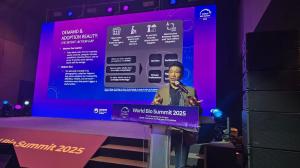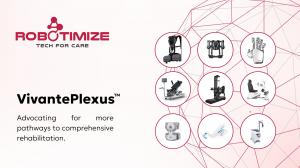From Pilots to Scale: Zen KOH Shares Age-Tech Pathways at World Bio Summit 2025, Seoul

Zen KOH Presenting at World Bio Summit 2025 in Seoul (17 Sept 2025), outlining Age-Tech pathways to scale AI-enabled rehab and assistive robotics.

World Bio Summit 2025, Seoul (17 Sept 2025): Zen KOH (second from left) with the organiser and fellow panellists posing on stage after the session.
Zen KOH outlines interoperable, evidence-driven Age-Tech that scales from hospital to home—turning pilots into access at World Bio Summit 2025, Seoul.
Framing his remarks within the Summit’s 2025 theme—“From Innovation to Access: Health Innovation for Everyone Everywhere”—KOH focused on execution: building outcome-proven, standards-conformant pathways that make advanced technologies usable, trustworthy, and affordable at scale.
“Ageing societies deserve more than showcase demos,” said Zen KOH. “Our job is to convert innovation into access—at pace—so people experience safer care, measurable gains and dignity where it matters most: at home. That is what happens when robotics, AI and clinicians act in concert.”
Why this matters now
Demographic ageing is reshaping health and social-care demand across Asia-Pacific and the OECD. By 2030, one in sixpeople globally will be aged 60 or over; by the mid-2030s, those aged 80+ will outnumber infants. This shift brings sustained pressure on rehabilitation capacity, long-term care and support services—all while most older adults prefer to age in place.
Yet adoption of even “obvious” safety and independence tools remains low in many markets. KOH identified the persistent intent–action gap—driven by total cost of ownership, privacy concerns, age-inappropriate design, weak service wraps, and unreliable connectivity in real homes—as the central challenge and opportunity for Age-Tech this decade.
A systems blueprint for Age-Tech (not a gadget story)
KOH positioned Age-Tech as a full-stack systems response—converging AI, robotics, biotech and connected homes—to extend healthspan and bend the cost curve. He presented a simple, serviceable architecture that bundles the stack into interoperable, outcomes-driven pathways:
Sense → Assist → Decide → Treat → Deliver/Pay
* Sense: remote patient-monitoring wearables and home IoT
* Assist: care robots, exoskeletons and smart appliances
* Decide: agentic AI plus clinical rules and safety guardrails
* Treat: from geroscience and neuromodulation to regenerative and cell/gene therapies
* Deliver/Pay: outcomes-based models (e.g., Robotics/Devices-as-a-Service)
This integrated framing underpins living-lab deployments where social assistive robots and personalised AI move beyond pilots into routine care.
Crossing the adoption chasm: design and operating standards
Scaled Age-Tech succeeds when it is trustworthy, effortless, reliable and serviced—and when every data point triggers a useful action by someone accountable. KOH set out six must-haves that convert evaluation criteria into procurement and deployment standards:
1. Control: user-owned permissions and privacy modes
2. Simplicity: no-app or zero-pairing setup; large targets; plain language
3. Reliability: offline-first operation; battery back-up; auto-failover
4. Service: installation, training, remote support and SLAs
5. Actionability: EHR/FHIR integration so data drives decisions
6. Signal hygiene: personalised thresholds and daily digests to avoid alert fatigue
He highlighted metrics that matter at scale—false-alarm rates, response times, events resolved, caregiver minutes saved per visit, cost-to-serve and active-device rates—to hold vendors and operators accountable for real-world value.
From novelty to necessity: robots embedded in care pathways
KOH emphasised that robotics deliver when embedded in care, coached into daily routines, and integrated with clinical systems—not when dropped in as standalone gadgets:
* Social/therapeutic robots: increase engagement in dementia care and reduce loneliness when programmes have clear goals (e.g., calm, sleep, interaction) and opt-in use.
* Assist robots for ADLs: enable single-caregiver transfers and bathing, lowering musculoskeletal injuries and preserving dignity; success depends on facility retrofits, safety certification, manual overrides and competency-based training.
* Autonomous patrol/alert: improve night safety and incident response when routes/no-go zones are mapped, thresholds tuned and integrations with nurse call and consent policies are in place.
Operational guardrails—role clarity, alert governance, connectivity resilience, privacy-by-design and a full service wrap from assessment to maintenance—are non-negotiable for safe scale.
Rehabilitation technologies: outcomes through protocol, interoperability and service
For clinical rehabilitation, standardised pathways and protocols—rather than isolated device purchases—drive outcomes and protect staff:
* Exoskeletons: support earlier mobilisation, higher therapy intensity and fewer caregiver injuries when accompanied by clear indications/contraindications, competency-based clinician training, safety checklists and reimbursement coding clarity.
* VR-based rehabilitation: increases adherence and dose for balance and lower-limb therapy; progress measured with recognised scales (e.g., TUG, Berg), repetition counts and goal-attainment scaling.
* Neuro-wearables: accelerate pathways (e.g., continuous motor-asymmetry monitoring for suspected stroke) when connected to 24/7 triage rules, EMS alerts, teleneuro consults and FHIR-aligned data capture.
The rule holds: protocolised, interoperable and serviced technology—supported by clinician dashboards (progression, fatigue, fall-risk flags; audit trails), privacy-by-design and reliable training/support—delivers sustainable results.
Healthcare delivery tech for home and facility
KOH identified four high-yield categories for home-first and facility operations:
1. Remote monitoring & ambient sensing to detect deterioration earlier and reduce avoidable A&E visits.
2. Voice/AI assistants for medication prompts, appointments and cognition/mood nudges—designed as augmentation, not replacement.
3. Ambient documentation AI to reduce after-hours paperwork, starting with high-friction notes (admissions, discharge, rehab progress).
4. Medication management combining smart dispensers, adherence sensing and pharmacist outreach.
Each requires operational guardrails and credible service wraps to avoid failure modes such as false alarms, surveillance perceptions or un-actioned signals.
Neutralising barriers to scale
KOH addressed five recurring blockers—and remedies:
* Usability gaps: age-representative testing; hard human-factors thresholds
* Trust & privacy concerns: user control; data minimisation; on-device options
* Connectivity fragility: offline-tolerant modes; cellular back-ups; building-level networks
* Fragmented procurement: bundle jobs-to-be-done with one accountable operator
* Evidence gaps: measure system effectiveness (clinical, operational, experience, equity), not just device efficacy
Five-move playbook: from pilot to platform
1. Start with the pathway, not the product. Select two high-yield pathways (e.g., falls prevention; post-stroke upper-limb; orthopaedic rehab at home; medication management) with shared success metrics.
2. Evidence-first roll-outs. Pair deployments with lean outcomes registries (function, safety, utilisation, experience, equity) to build payer-ready dossiers.
3. Workflow-centred integration. Redesign roles, escalation and checklists so clinicians spend time on therapy—not “babysitting” devices; implement alert governance.
4. Interoperability guardrails. Require open APIs and HL7/FHIR mappings; set content contracts and consent logs for portability and privacy.
5. Financing and reimbursement fit. Blend leasing/subscription with outcomes-linked payments; align on uptime, utilisation and patient outcomes; treat bundles as services, not gadgets.
Message: prove it, then scale it—with standards-led procurement and population-level outcomes.
A Korea-ready blueprint: from pilots to platforms
KOH argued that Korea—and similarly positioned economies—can convert engineering excellence into serviced, standards-conformant Age-Tech bundles that domestic payers trust and neighbours can adopt. Korea’s strengths in robotics, sensors, semiconductors, 5G/edge and ISO-certified manufacturing—combined with mature hospital testbeds and informatics expertise—make it an ideal launchpad.
He highlighted three exportable programme bundles, designed for localisation in Japan, China and ASEAN:
* Safe@Home — alerts, sensors and social-robot check-ins
* Rehab@Home — RPM plus assistive robotics with therapist tele-supervision
* Cognition@Home — cognitive support, social connectivity and SAR coaching
KOH called for standards-led procurement (usability, accessibility, interoperability as gating criteria), national outcomes registries with common data contracts, and a regulatory sandbox for RPM to address privacy, security and bias at scale.
Panel contribution: turning consensus into execution
In Session 2: “Aging & Health Tech — Longevity with Dignity through Innovation”, KOH joined experts across policy, finance, robotics and clinical science to translate consensus into executable strategies for super-ageing societies. Topics included global policy readiness, robotics in care and rehabilitation, the present and future of anti-ageing medical technologies, Japan’s advances in regenerative medicine and international cooperation for technology-enabled healthy ageing.
KOH’s dual role—presenter and panellist—underscored his focus on translation to practice: making evidence, interoperability, and service models the default, not the exception.
Call to action
* Commit to standards: Make usability, accessibility, interoperability and privacy-by-design gating criteria for procurement.
* Fund evidence: Stand up outcomes registries and living-lab programmes that report system-level effectiveness and equity.
* Ship serviced bundles: Contract for jobs-to-be-done (e.g., Safe@Home, Rehab@Home) with one accountable operator and clear KPI dashboards.
In short: prove it, then scale it.
About Zen KOH
Zen KOH is a recognised leader in neurorehabilitation robotics and intelligent care technologies. He serves as Co-Founder & CEO, MotusAcademy; Strategic Industry Advisor & Entrepreneur-in-Residence, KITE-UHN (Toronto Rehab Institute); Ambassador, IISART; and Managing Editor & Editorial Board Member, Journal of Rehabilitation Methods and Technologies (JRMT). His work sits at the intersection of healthcare robotics, clinical science, engineering and health-system adoption, with a focus on standards-led, outcomes-based scale-up.
About World Bio Summit
World Bio Summit convenes ministers, international organisations, clinicians, researchers and industry leaders to accelerate the translation of breakthrough health innovations into equitable access and improved population outcomes. The 2025 theme is “From Innovation to Access: Health Innovation for Everyone Everywhere.”
Jerry HONG
Robotimize Group
+60 11-1224 1674
email us here
Legal Disclaimer:
EIN Presswire provides this news content "as is" without warranty of any kind. We do not accept any responsibility or liability for the accuracy, content, images, videos, licenses, completeness, legality, or reliability of the information contained in this article. If you have any complaints or copyright issues related to this article, kindly contact the author above.



